Critical Analysis of Aged Care Policy for Older People with Delirium
VerifiedAdded on 2021/06/16
|24
|5184
|38
Report
AI Summary
This report critically analyzes the care and management policy for older people at risk of delirium in Australia, addressing the increasing prevalence of delirium in hospitalized older adults. It examines the current policy's strengths and weaknesses, including its strategic planning, assessment, and monitoring of older individuals. The report highlights the need for policy updates, particularly the integration of assistive technology and the involvement of patients and their families. A comprehensive literature review is conducted, exploring evidence-based practices and the impact of delirium on older individuals. The report also discusses the consultation process, including surveys, problem identification, and discussions with various stakeholders, to inform policy revisions. Ultimately, the report recommends updates to the policy to enhance the safety and quality of care for older patients with delirium, emphasizing the use of assistive technology and the engagement of patients and families in the care process to avoid preventable errors and improve patient outcomes.
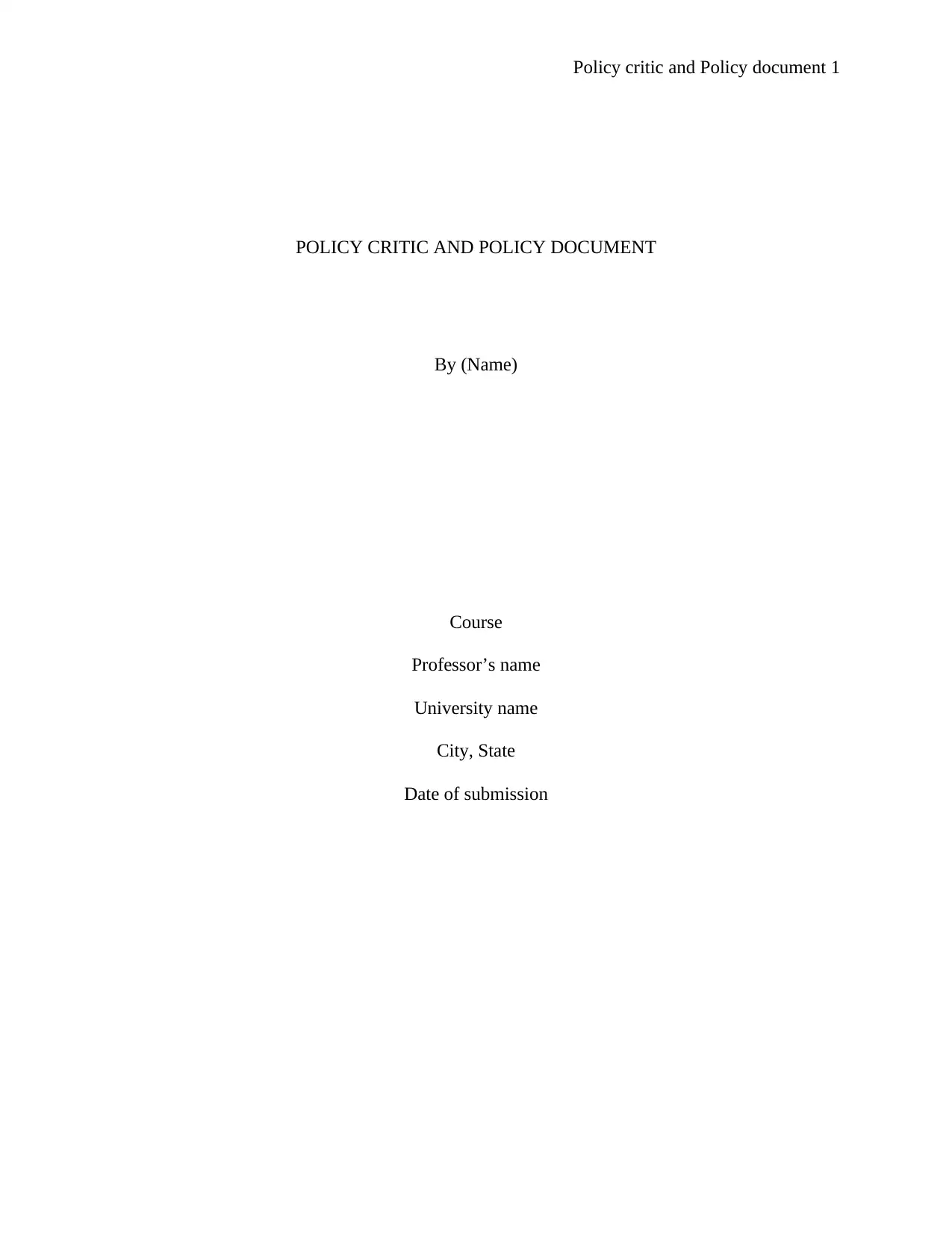
Policy critic and Policy document 1
POLICY CRITIC AND POLICY DOCUMENT
By (Name)
Course
Professor’s name
University name
City, State
Date of submission
POLICY CRITIC AND POLICY DOCUMENT
By (Name)
Course
Professor’s name
University name
City, State
Date of submission
Paraphrase This Document
Need a fresh take? Get an instant paraphrase of this document with our AI Paraphraser
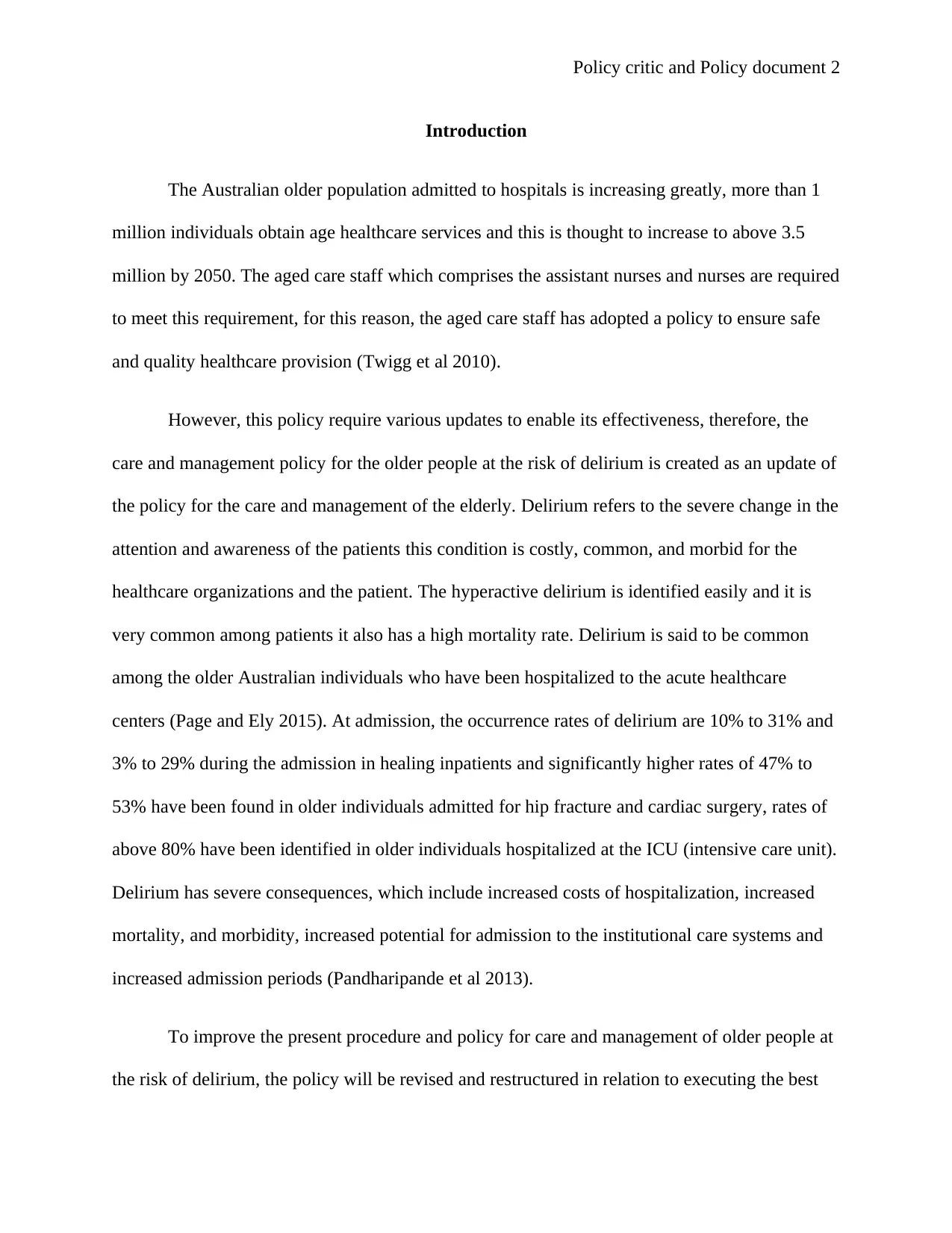
Policy critic and Policy document 2
Introduction
The Australian older population admitted to hospitals is increasing greatly, more than 1
million individuals obtain age healthcare services and this is thought to increase to above 3.5
million by 2050. The aged care staff which comprises the assistant nurses and nurses are required
to meet this requirement, for this reason, the aged care staff has adopted a policy to ensure safe
and quality healthcare provision (Twigg et al 2010).
However, this policy require various updates to enable its effectiveness, therefore, the
care and management policy for the older people at the risk of delirium is created as an update of
the policy for the care and management of the elderly. Delirium refers to the severe change in the
attention and awareness of the patients this condition is costly, common, and morbid for the
healthcare organizations and the patient. The hyperactive delirium is identified easily and it is
very common among patients it also has a high mortality rate. Delirium is said to be common
among the older Australian individuals who have been hospitalized to the acute healthcare
centers (Page and Ely 2015). At admission, the occurrence rates of delirium are 10% to 31% and
3% to 29% during the admission in healing inpatients and significantly higher rates of 47% to
53% have been found in older individuals admitted for hip fracture and cardiac surgery, rates of
above 80% have been identified in older individuals hospitalized at the ICU (intensive care unit).
Delirium has severe consequences, which include increased costs of hospitalization, increased
mortality, and morbidity, increased potential for admission to the institutional care systems and
increased admission periods (Pandharipande et al 2013).
To improve the present procedure and policy for care and management of older people at
the risk of delirium, the policy will be revised and restructured in relation to executing the best
Introduction
The Australian older population admitted to hospitals is increasing greatly, more than 1
million individuals obtain age healthcare services and this is thought to increase to above 3.5
million by 2050. The aged care staff which comprises the assistant nurses and nurses are required
to meet this requirement, for this reason, the aged care staff has adopted a policy to ensure safe
and quality healthcare provision (Twigg et al 2010).
However, this policy require various updates to enable its effectiveness, therefore, the
care and management policy for the older people at the risk of delirium is created as an update of
the policy for the care and management of the elderly. Delirium refers to the severe change in the
attention and awareness of the patients this condition is costly, common, and morbid for the
healthcare organizations and the patient. The hyperactive delirium is identified easily and it is
very common among patients it also has a high mortality rate. Delirium is said to be common
among the older Australian individuals who have been hospitalized to the acute healthcare
centers (Page and Ely 2015). At admission, the occurrence rates of delirium are 10% to 31% and
3% to 29% during the admission in healing inpatients and significantly higher rates of 47% to
53% have been found in older individuals admitted for hip fracture and cardiac surgery, rates of
above 80% have been identified in older individuals hospitalized at the ICU (intensive care unit).
Delirium has severe consequences, which include increased costs of hospitalization, increased
mortality, and morbidity, increased potential for admission to the institutional care systems and
increased admission periods (Pandharipande et al 2013).
To improve the present procedure and policy for care and management of older people at
the risk of delirium, the policy will be revised and restructured in relation to executing the best
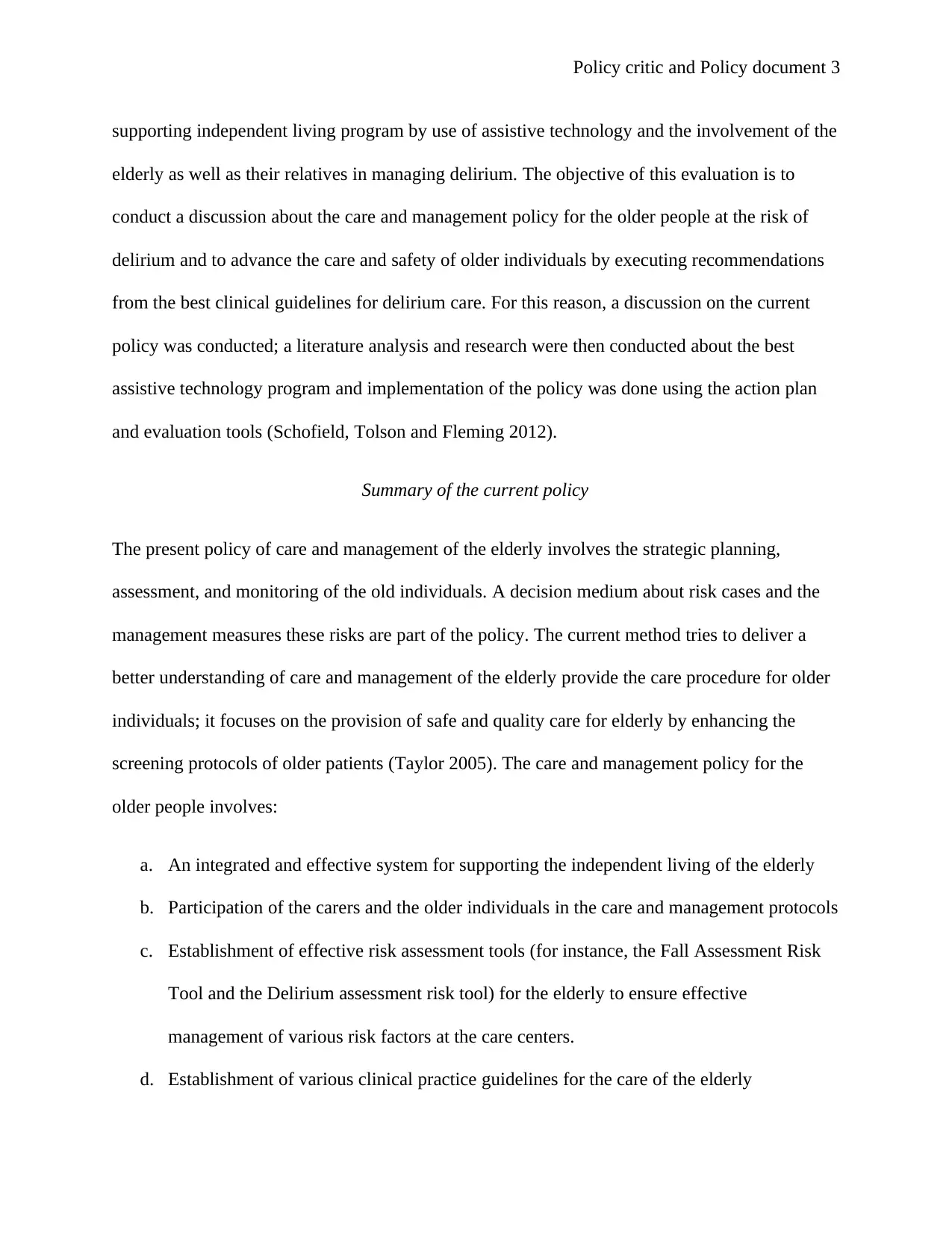
Policy critic and Policy document 3
supporting independent living program by use of assistive technology and the involvement of the
elderly as well as their relatives in managing delirium. The objective of this evaluation is to
conduct a discussion about the care and management policy for the older people at the risk of
delirium and to advance the care and safety of older individuals by executing recommendations
from the best clinical guidelines for delirium care. For this reason, a discussion on the current
policy was conducted; a literature analysis and research were then conducted about the best
assistive technology program and implementation of the policy was done using the action plan
and evaluation tools (Schofield, Tolson and Fleming 2012).
Summary of the current policy
The present policy of care and management of the elderly involves the strategic planning,
assessment, and monitoring of the old individuals. A decision medium about risk cases and the
management measures these risks are part of the policy. The current method tries to deliver a
better understanding of care and management of the elderly provide the care procedure for older
individuals; it focuses on the provision of safe and quality care for elderly by enhancing the
screening protocols of older patients (Taylor 2005). The care and management policy for the
older people involves:
a. An integrated and effective system for supporting the independent living of the elderly
b. Participation of the carers and the older individuals in the care and management protocols
c. Establishment of effective risk assessment tools (for instance, the Fall Assessment Risk
Tool and the Delirium assessment risk tool) for the elderly to ensure effective
management of various risk factors at the care centers.
d. Establishment of various clinical practice guidelines for the care of the elderly
supporting independent living program by use of assistive technology and the involvement of the
elderly as well as their relatives in managing delirium. The objective of this evaluation is to
conduct a discussion about the care and management policy for the older people at the risk of
delirium and to advance the care and safety of older individuals by executing recommendations
from the best clinical guidelines for delirium care. For this reason, a discussion on the current
policy was conducted; a literature analysis and research were then conducted about the best
assistive technology program and implementation of the policy was done using the action plan
and evaluation tools (Schofield, Tolson and Fleming 2012).
Summary of the current policy
The present policy of care and management of the elderly involves the strategic planning,
assessment, and monitoring of the old individuals. A decision medium about risk cases and the
management measures these risks are part of the policy. The current method tries to deliver a
better understanding of care and management of the elderly provide the care procedure for older
individuals; it focuses on the provision of safe and quality care for elderly by enhancing the
screening protocols of older patients (Taylor 2005). The care and management policy for the
older people involves:
a. An integrated and effective system for supporting the independent living of the elderly
b. Participation of the carers and the older individuals in the care and management protocols
c. Establishment of effective risk assessment tools (for instance, the Fall Assessment Risk
Tool and the Delirium assessment risk tool) for the elderly to ensure effective
management of various risk factors at the care centers.
d. Establishment of various clinical practice guidelines for the care of the elderly
⊘ This is a preview!⊘
Do you want full access?
Subscribe today to unlock all pages.

Trusted by 1+ million students worldwide
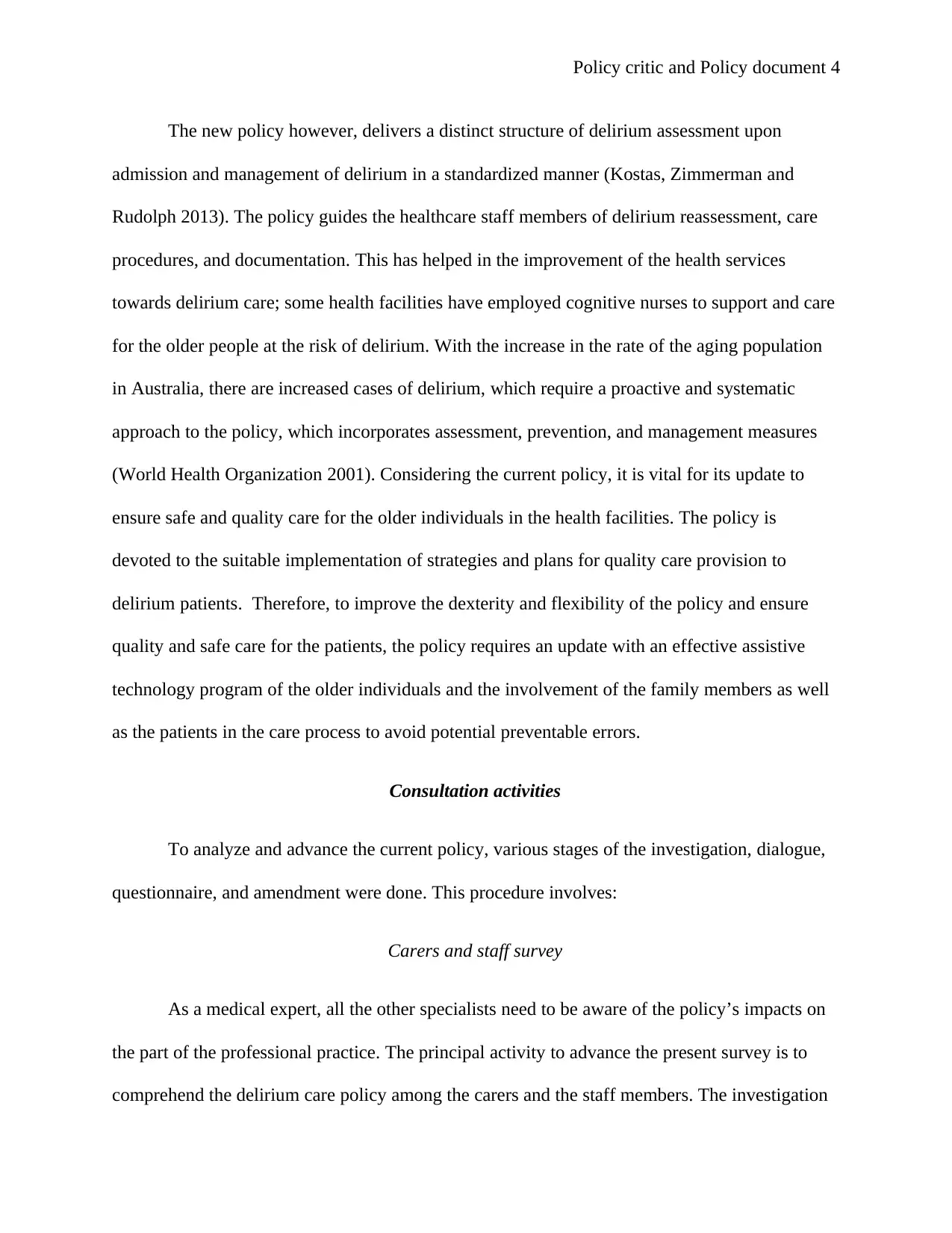
Policy critic and Policy document 4
The new policy however, delivers a distinct structure of delirium assessment upon
admission and management of delirium in a standardized manner (Kostas, Zimmerman and
Rudolph 2013). The policy guides the healthcare staff members of delirium reassessment, care
procedures, and documentation. This has helped in the improvement of the health services
towards delirium care; some health facilities have employed cognitive nurses to support and care
for the older people at the risk of delirium. With the increase in the rate of the aging population
in Australia, there are increased cases of delirium, which require a proactive and systematic
approach to the policy, which incorporates assessment, prevention, and management measures
(World Health Organization 2001). Considering the current policy, it is vital for its update to
ensure safe and quality care for the older individuals in the health facilities. The policy is
devoted to the suitable implementation of strategies and plans for quality care provision to
delirium patients. Therefore, to improve the dexterity and flexibility of the policy and ensure
quality and safe care for the patients, the policy requires an update with an effective assistive
technology program of the older individuals and the involvement of the family members as well
as the patients in the care process to avoid potential preventable errors.
Consultation activities
To analyze and advance the current policy, various stages of the investigation, dialogue,
questionnaire, and amendment were done. This procedure involves:
Carers and staff survey
As a medical expert, all the other specialists need to be aware of the policy’s impacts on
the part of the professional practice. The principal activity to advance the present survey is to
comprehend the delirium care policy among the carers and the staff members. The investigation
The new policy however, delivers a distinct structure of delirium assessment upon
admission and management of delirium in a standardized manner (Kostas, Zimmerman and
Rudolph 2013). The policy guides the healthcare staff members of delirium reassessment, care
procedures, and documentation. This has helped in the improvement of the health services
towards delirium care; some health facilities have employed cognitive nurses to support and care
for the older people at the risk of delirium. With the increase in the rate of the aging population
in Australia, there are increased cases of delirium, which require a proactive and systematic
approach to the policy, which incorporates assessment, prevention, and management measures
(World Health Organization 2001). Considering the current policy, it is vital for its update to
ensure safe and quality care for the older individuals in the health facilities. The policy is
devoted to the suitable implementation of strategies and plans for quality care provision to
delirium patients. Therefore, to improve the dexterity and flexibility of the policy and ensure
quality and safe care for the patients, the policy requires an update with an effective assistive
technology program of the older individuals and the involvement of the family members as well
as the patients in the care process to avoid potential preventable errors.
Consultation activities
To analyze and advance the current policy, various stages of the investigation, dialogue,
questionnaire, and amendment were done. This procedure involves:
Carers and staff survey
As a medical expert, all the other specialists need to be aware of the policy’s impacts on
the part of the professional practice. The principal activity to advance the present survey is to
comprehend the delirium care policy among the carers and the staff members. The investigation
Paraphrase This Document
Need a fresh take? Get an instant paraphrase of this document with our AI Paraphraser
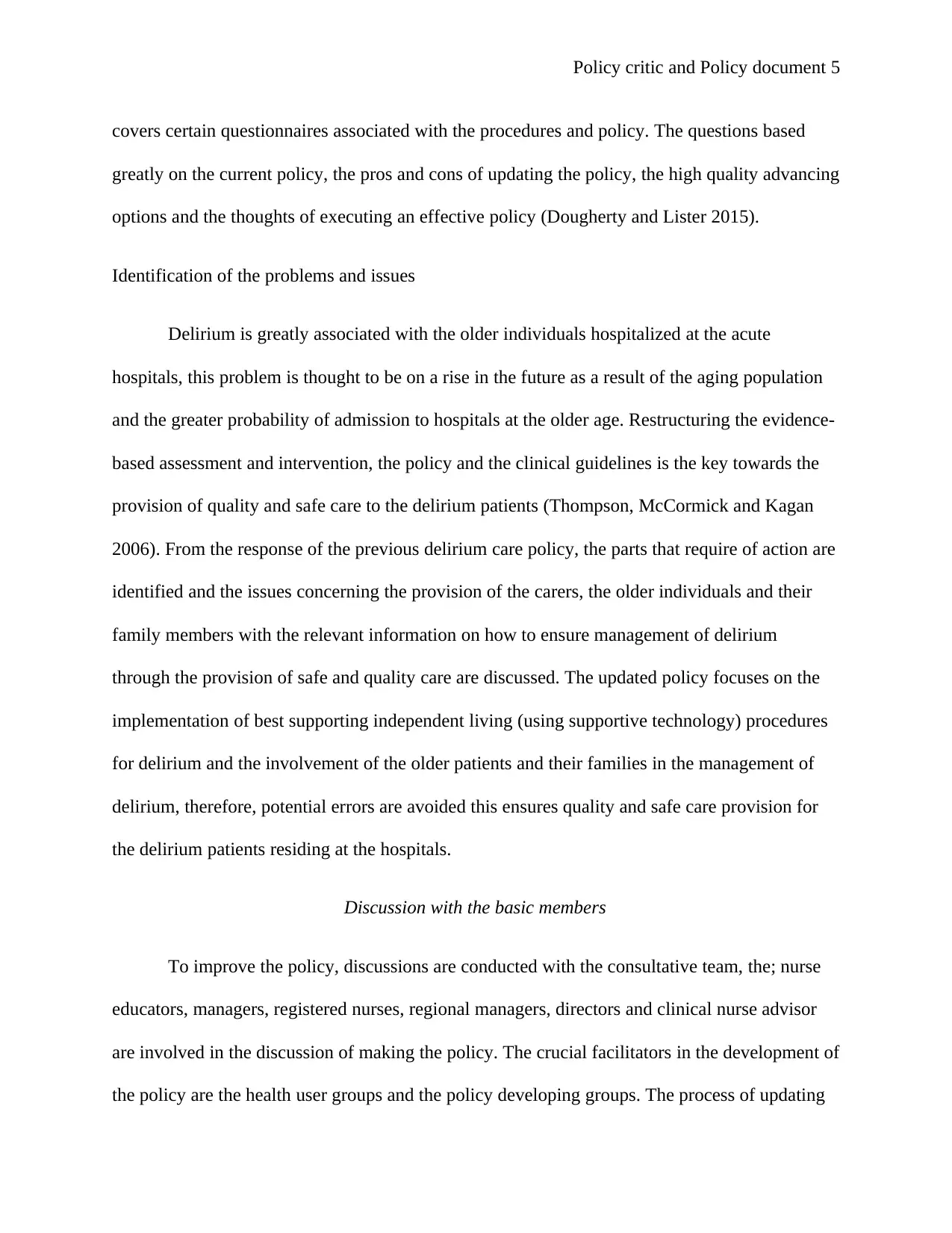
Policy critic and Policy document 5
covers certain questionnaires associated with the procedures and policy. The questions based
greatly on the current policy, the pros and cons of updating the policy, the high quality advancing
options and the thoughts of executing an effective policy (Dougherty and Lister 2015).
Identification of the problems and issues
Delirium is greatly associated with the older individuals hospitalized at the acute
hospitals, this problem is thought to be on a rise in the future as a result of the aging population
and the greater probability of admission to hospitals at the older age. Restructuring the evidence-
based assessment and intervention, the policy and the clinical guidelines is the key towards the
provision of quality and safe care to the delirium patients (Thompson, McCormick and Kagan
2006). From the response of the previous delirium care policy, the parts that require of action are
identified and the issues concerning the provision of the carers, the older individuals and their
family members with the relevant information on how to ensure management of delirium
through the provision of safe and quality care are discussed. The updated policy focuses on the
implementation of best supporting independent living (using supportive technology) procedures
for delirium and the involvement of the older patients and their families in the management of
delirium, therefore, potential errors are avoided this ensures quality and safe care provision for
the delirium patients residing at the hospitals.
Discussion with the basic members
To improve the policy, discussions are conducted with the consultative team, the; nurse
educators, managers, registered nurses, regional managers, directors and clinical nurse advisor
are involved in the discussion of making the policy. The crucial facilitators in the development of
the policy are the health user groups and the policy developing groups. The process of updating
covers certain questionnaires associated with the procedures and policy. The questions based
greatly on the current policy, the pros and cons of updating the policy, the high quality advancing
options and the thoughts of executing an effective policy (Dougherty and Lister 2015).
Identification of the problems and issues
Delirium is greatly associated with the older individuals hospitalized at the acute
hospitals, this problem is thought to be on a rise in the future as a result of the aging population
and the greater probability of admission to hospitals at the older age. Restructuring the evidence-
based assessment and intervention, the policy and the clinical guidelines is the key towards the
provision of quality and safe care to the delirium patients (Thompson, McCormick and Kagan
2006). From the response of the previous delirium care policy, the parts that require of action are
identified and the issues concerning the provision of the carers, the older individuals and their
family members with the relevant information on how to ensure management of delirium
through the provision of safe and quality care are discussed. The updated policy focuses on the
implementation of best supporting independent living (using supportive technology) procedures
for delirium and the involvement of the older patients and their families in the management of
delirium, therefore, potential errors are avoided this ensures quality and safe care provision for
the delirium patients residing at the hospitals.
Discussion with the basic members
To improve the policy, discussions are conducted with the consultative team, the; nurse
educators, managers, registered nurses, regional managers, directors and clinical nurse advisor
are involved in the discussion of making the policy. The crucial facilitators in the development of
the policy are the health user groups and the policy developing groups. The process of updating
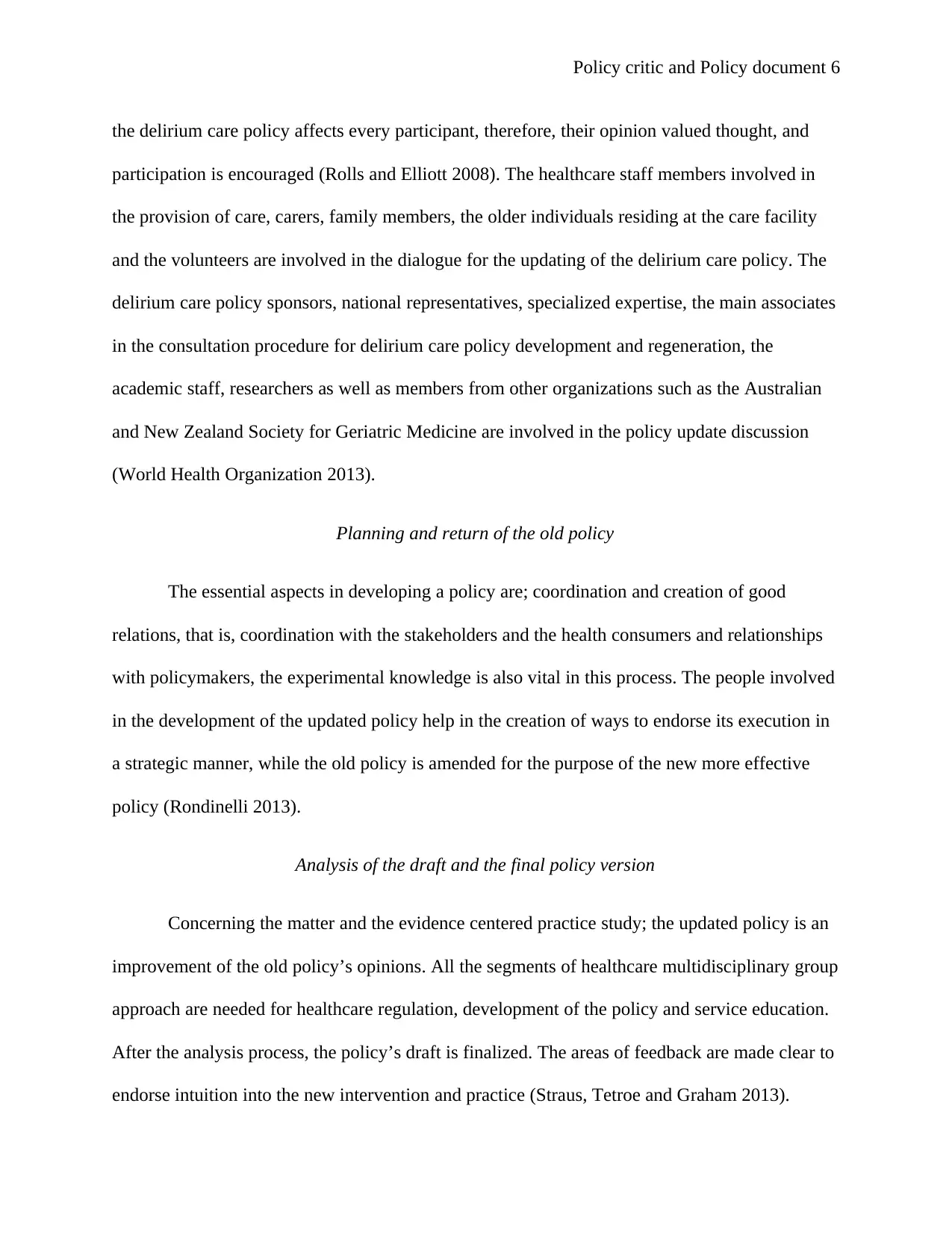
Policy critic and Policy document 6
the delirium care policy affects every participant, therefore, their opinion valued thought, and
participation is encouraged (Rolls and Elliott 2008). The healthcare staff members involved in
the provision of care, carers, family members, the older individuals residing at the care facility
and the volunteers are involved in the dialogue for the updating of the delirium care policy. The
delirium care policy sponsors, national representatives, specialized expertise, the main associates
in the consultation procedure for delirium care policy development and regeneration, the
academic staff, researchers as well as members from other organizations such as the Australian
and New Zealand Society for Geriatric Medicine are involved in the policy update discussion
(World Health Organization 2013).
Planning and return of the old policy
The essential aspects in developing a policy are; coordination and creation of good
relations, that is, coordination with the stakeholders and the health consumers and relationships
with policymakers, the experimental knowledge is also vital in this process. The people involved
in the development of the updated policy help in the creation of ways to endorse its execution in
a strategic manner, while the old policy is amended for the purpose of the new more effective
policy (Rondinelli 2013).
Analysis of the draft and the final policy version
Concerning the matter and the evidence centered practice study; the updated policy is an
improvement of the old policy’s opinions. All the segments of healthcare multidisciplinary group
approach are needed for healthcare regulation, development of the policy and service education.
After the analysis process, the policy’s draft is finalized. The areas of feedback are made clear to
endorse intuition into the new intervention and practice (Straus, Tetroe and Graham 2013).
the delirium care policy affects every participant, therefore, their opinion valued thought, and
participation is encouraged (Rolls and Elliott 2008). The healthcare staff members involved in
the provision of care, carers, family members, the older individuals residing at the care facility
and the volunteers are involved in the dialogue for the updating of the delirium care policy. The
delirium care policy sponsors, national representatives, specialized expertise, the main associates
in the consultation procedure for delirium care policy development and regeneration, the
academic staff, researchers as well as members from other organizations such as the Australian
and New Zealand Society for Geriatric Medicine are involved in the policy update discussion
(World Health Organization 2013).
Planning and return of the old policy
The essential aspects in developing a policy are; coordination and creation of good
relations, that is, coordination with the stakeholders and the health consumers and relationships
with policymakers, the experimental knowledge is also vital in this process. The people involved
in the development of the updated policy help in the creation of ways to endorse its execution in
a strategic manner, while the old policy is amended for the purpose of the new more effective
policy (Rondinelli 2013).
Analysis of the draft and the final policy version
Concerning the matter and the evidence centered practice study; the updated policy is an
improvement of the old policy’s opinions. All the segments of healthcare multidisciplinary group
approach are needed for healthcare regulation, development of the policy and service education.
After the analysis process, the policy’s draft is finalized. The areas of feedback are made clear to
endorse intuition into the new intervention and practice (Straus, Tetroe and Graham 2013).
⊘ This is a preview!⊘
Do you want full access?
Subscribe today to unlock all pages.

Trusted by 1+ million students worldwide
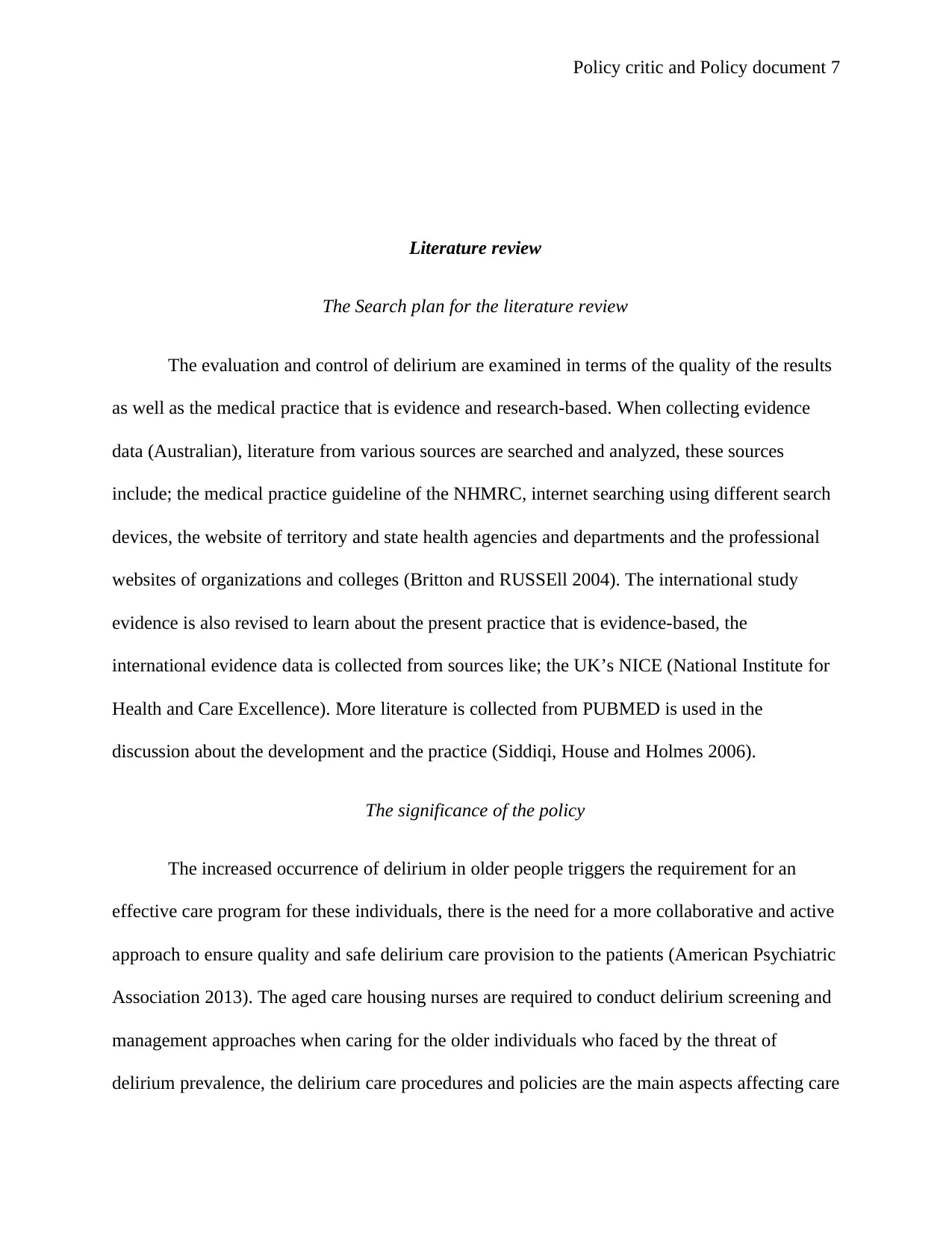
Policy critic and Policy document 7
Literature review
The Search plan for the literature review
The evaluation and control of delirium are examined in terms of the quality of the results
as well as the medical practice that is evidence and research-based. When collecting evidence
data (Australian), literature from various sources are searched and analyzed, these sources
include; the medical practice guideline of the NHMRC, internet searching using different search
devices, the website of territory and state health agencies and departments and the professional
websites of organizations and colleges (Britton and RUSSEll 2004). The international study
evidence is also revised to learn about the present practice that is evidence-based, the
international evidence data is collected from sources like; the UK’s NICE (National Institute for
Health and Care Excellence). More literature is collected from PUBMED is used in the
discussion about the development and the practice (Siddiqi, House and Holmes 2006).
The significance of the policy
The increased occurrence of delirium in older people triggers the requirement for an
effective care program for these individuals, there is the need for a more collaborative and active
approach to ensure quality and safe delirium care provision to the patients (American Psychiatric
Association 2013). The aged care housing nurses are required to conduct delirium screening and
management approaches when caring for the older individuals who faced by the threat of
delirium prevalence, the delirium care procedures and policies are the main aspects affecting care
Literature review
The Search plan for the literature review
The evaluation and control of delirium are examined in terms of the quality of the results
as well as the medical practice that is evidence and research-based. When collecting evidence
data (Australian), literature from various sources are searched and analyzed, these sources
include; the medical practice guideline of the NHMRC, internet searching using different search
devices, the website of territory and state health agencies and departments and the professional
websites of organizations and colleges (Britton and RUSSEll 2004). The international study
evidence is also revised to learn about the present practice that is evidence-based, the
international evidence data is collected from sources like; the UK’s NICE (National Institute for
Health and Care Excellence). More literature is collected from PUBMED is used in the
discussion about the development and the practice (Siddiqi, House and Holmes 2006).
The significance of the policy
The increased occurrence of delirium in older people triggers the requirement for an
effective care program for these individuals, there is the need for a more collaborative and active
approach to ensure quality and safe delirium care provision to the patients (American Psychiatric
Association 2013). The aged care housing nurses are required to conduct delirium screening and
management approaches when caring for the older individuals who faced by the threat of
delirium prevalence, the delirium care procedures and policies are the main aspects affecting care
Paraphrase This Document
Need a fresh take? Get an instant paraphrase of this document with our AI Paraphraser
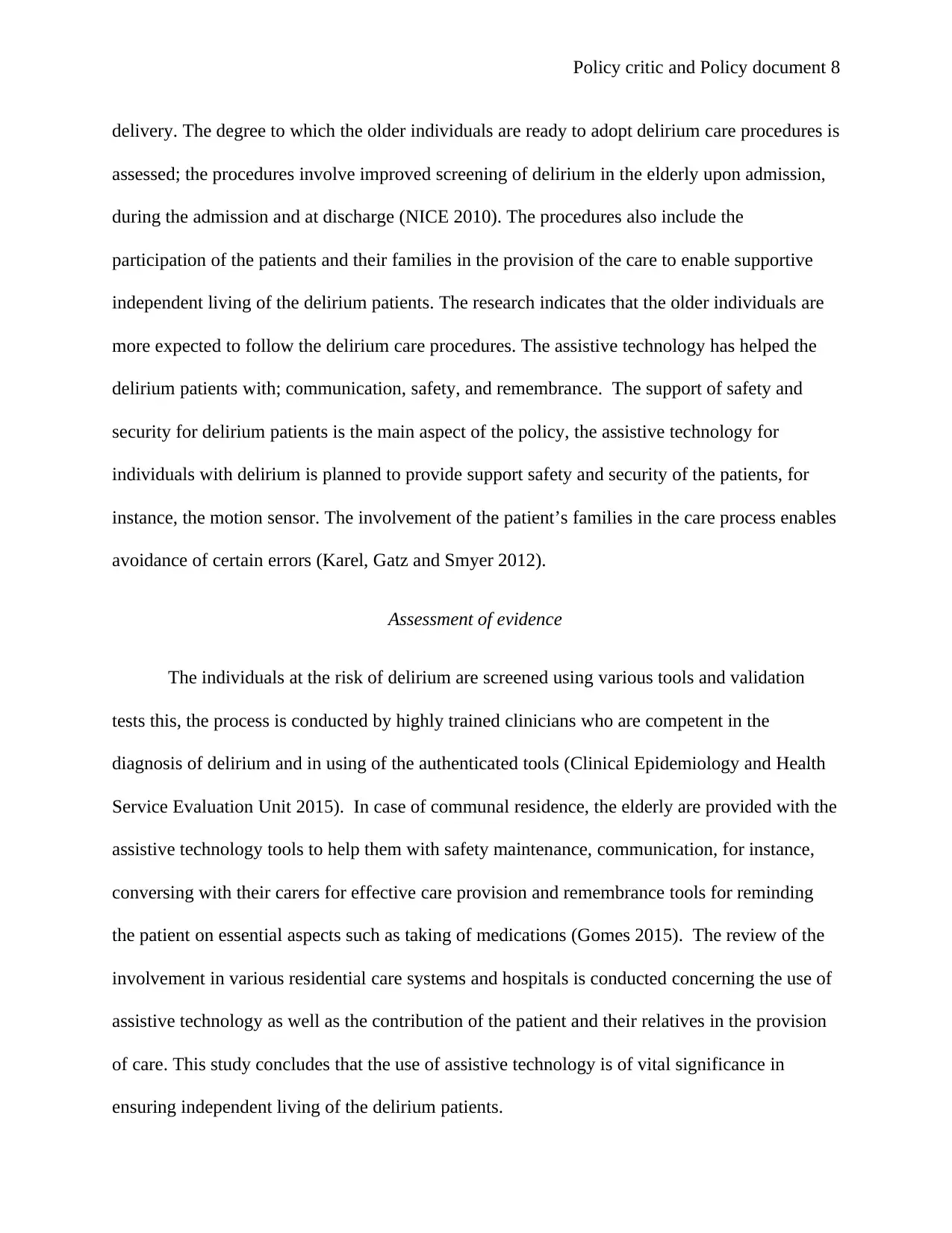
Policy critic and Policy document 8
delivery. The degree to which the older individuals are ready to adopt delirium care procedures is
assessed; the procedures involve improved screening of delirium in the elderly upon admission,
during the admission and at discharge (NICE 2010). The procedures also include the
participation of the patients and their families in the provision of the care to enable supportive
independent living of the delirium patients. The research indicates that the older individuals are
more expected to follow the delirium care procedures. The assistive technology has helped the
delirium patients with; communication, safety, and remembrance. The support of safety and
security for delirium patients is the main aspect of the policy, the assistive technology for
individuals with delirium is planned to provide support safety and security of the patients, for
instance, the motion sensor. The involvement of the patient’s families in the care process enables
avoidance of certain errors (Karel, Gatz and Smyer 2012).
Assessment of evidence
The individuals at the risk of delirium are screened using various tools and validation
tests this, the process is conducted by highly trained clinicians who are competent in the
diagnosis of delirium and in using of the authenticated tools (Clinical Epidemiology and Health
Service Evaluation Unit 2015). In case of communal residence, the elderly are provided with the
assistive technology tools to help them with safety maintenance, communication, for instance,
conversing with their carers for effective care provision and remembrance tools for reminding
the patient on essential aspects such as taking of medications (Gomes 2015). The review of the
involvement in various residential care systems and hospitals is conducted concerning the use of
assistive technology as well as the contribution of the patient and their relatives in the provision
of care. This study concludes that the use of assistive technology is of vital significance in
ensuring independent living of the delirium patients.
delivery. The degree to which the older individuals are ready to adopt delirium care procedures is
assessed; the procedures involve improved screening of delirium in the elderly upon admission,
during the admission and at discharge (NICE 2010). The procedures also include the
participation of the patients and their families in the provision of the care to enable supportive
independent living of the delirium patients. The research indicates that the older individuals are
more expected to follow the delirium care procedures. The assistive technology has helped the
delirium patients with; communication, safety, and remembrance. The support of safety and
security for delirium patients is the main aspect of the policy, the assistive technology for
individuals with delirium is planned to provide support safety and security of the patients, for
instance, the motion sensor. The involvement of the patient’s families in the care process enables
avoidance of certain errors (Karel, Gatz and Smyer 2012).
Assessment of evidence
The individuals at the risk of delirium are screened using various tools and validation
tests this, the process is conducted by highly trained clinicians who are competent in the
diagnosis of delirium and in using of the authenticated tools (Clinical Epidemiology and Health
Service Evaluation Unit 2015). In case of communal residence, the elderly are provided with the
assistive technology tools to help them with safety maintenance, communication, for instance,
conversing with their carers for effective care provision and remembrance tools for reminding
the patient on essential aspects such as taking of medications (Gomes 2015). The review of the
involvement in various residential care systems and hospitals is conducted concerning the use of
assistive technology as well as the contribution of the patient and their relatives in the provision
of care. This study concludes that the use of assistive technology is of vital significance in
ensuring independent living of the delirium patients.
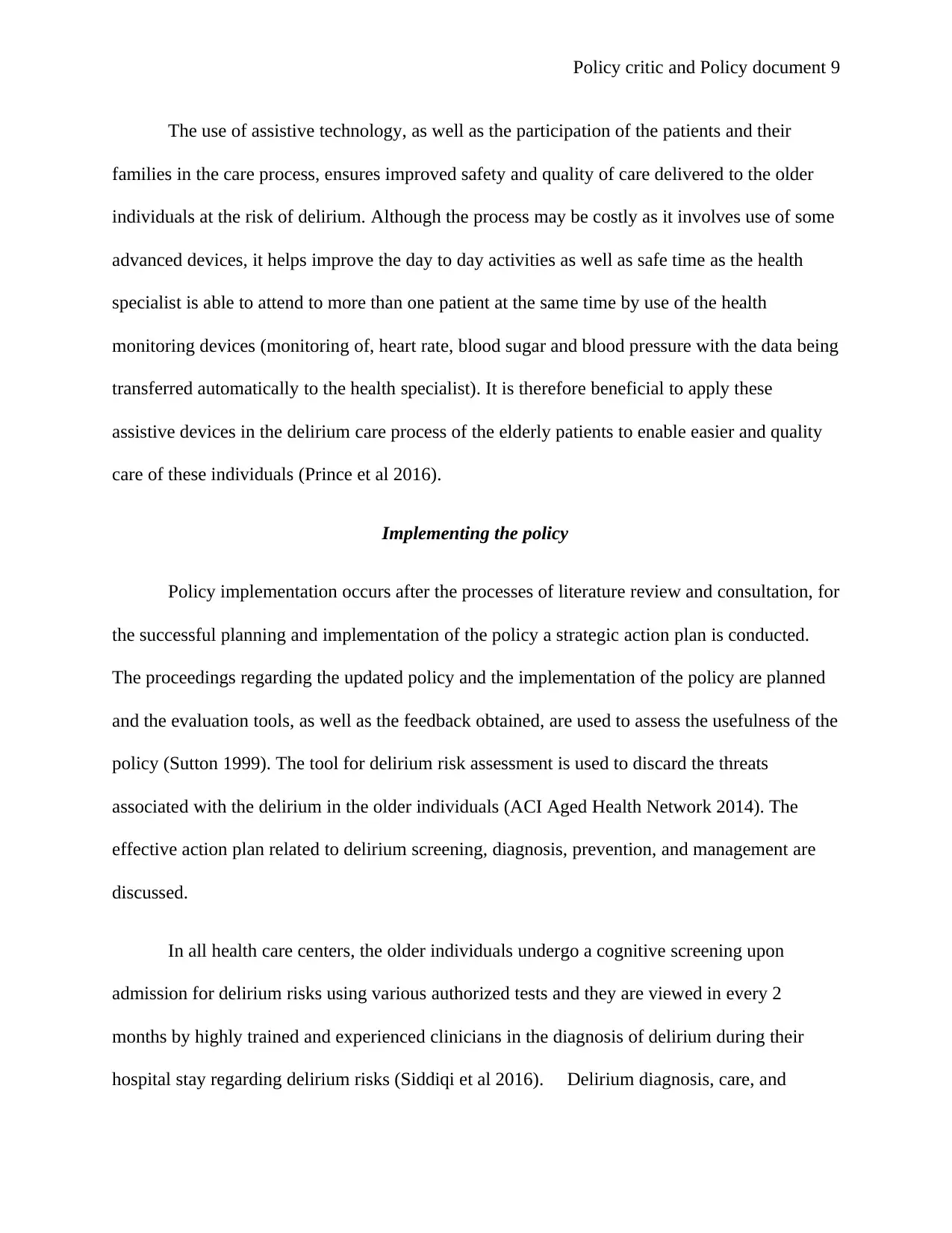
Policy critic and Policy document 9
The use of assistive technology, as well as the participation of the patients and their
families in the care process, ensures improved safety and quality of care delivered to the older
individuals at the risk of delirium. Although the process may be costly as it involves use of some
advanced devices, it helps improve the day to day activities as well as safe time as the health
specialist is able to attend to more than one patient at the same time by use of the health
monitoring devices (monitoring of, heart rate, blood sugar and blood pressure with the data being
transferred automatically to the health specialist). It is therefore beneficial to apply these
assistive devices in the delirium care process of the elderly patients to enable easier and quality
care of these individuals (Prince et al 2016).
Implementing the policy
Policy implementation occurs after the processes of literature review and consultation, for
the successful planning and implementation of the policy a strategic action plan is conducted.
The proceedings regarding the updated policy and the implementation of the policy are planned
and the evaluation tools, as well as the feedback obtained, are used to assess the usefulness of the
policy (Sutton 1999). The tool for delirium risk assessment is used to discard the threats
associated with the delirium in the older individuals (ACI Aged Health Network 2014). The
effective action plan related to delirium screening, diagnosis, prevention, and management are
discussed.
In all health care centers, the older individuals undergo a cognitive screening upon
admission for delirium risks using various authorized tests and they are viewed in every 2
months by highly trained and experienced clinicians in the diagnosis of delirium during their
hospital stay regarding delirium risks (Siddiqi et al 2016). Delirium diagnosis, care, and
The use of assistive technology, as well as the participation of the patients and their
families in the care process, ensures improved safety and quality of care delivered to the older
individuals at the risk of delirium. Although the process may be costly as it involves use of some
advanced devices, it helps improve the day to day activities as well as safe time as the health
specialist is able to attend to more than one patient at the same time by use of the health
monitoring devices (monitoring of, heart rate, blood sugar and blood pressure with the data being
transferred automatically to the health specialist). It is therefore beneficial to apply these
assistive devices in the delirium care process of the elderly patients to enable easier and quality
care of these individuals (Prince et al 2016).
Implementing the policy
Policy implementation occurs after the processes of literature review and consultation, for
the successful planning and implementation of the policy a strategic action plan is conducted.
The proceedings regarding the updated policy and the implementation of the policy are planned
and the evaluation tools, as well as the feedback obtained, are used to assess the usefulness of the
policy (Sutton 1999). The tool for delirium risk assessment is used to discard the threats
associated with the delirium in the older individuals (ACI Aged Health Network 2014). The
effective action plan related to delirium screening, diagnosis, prevention, and management are
discussed.
In all health care centers, the older individuals undergo a cognitive screening upon
admission for delirium risks using various authorized tests and they are viewed in every 2
months by highly trained and experienced clinicians in the diagnosis of delirium during their
hospital stay regarding delirium risks (Siddiqi et al 2016). Delirium diagnosis, care, and
⊘ This is a preview!⊘
Do you want full access?
Subscribe today to unlock all pages.

Trusted by 1+ million students worldwide
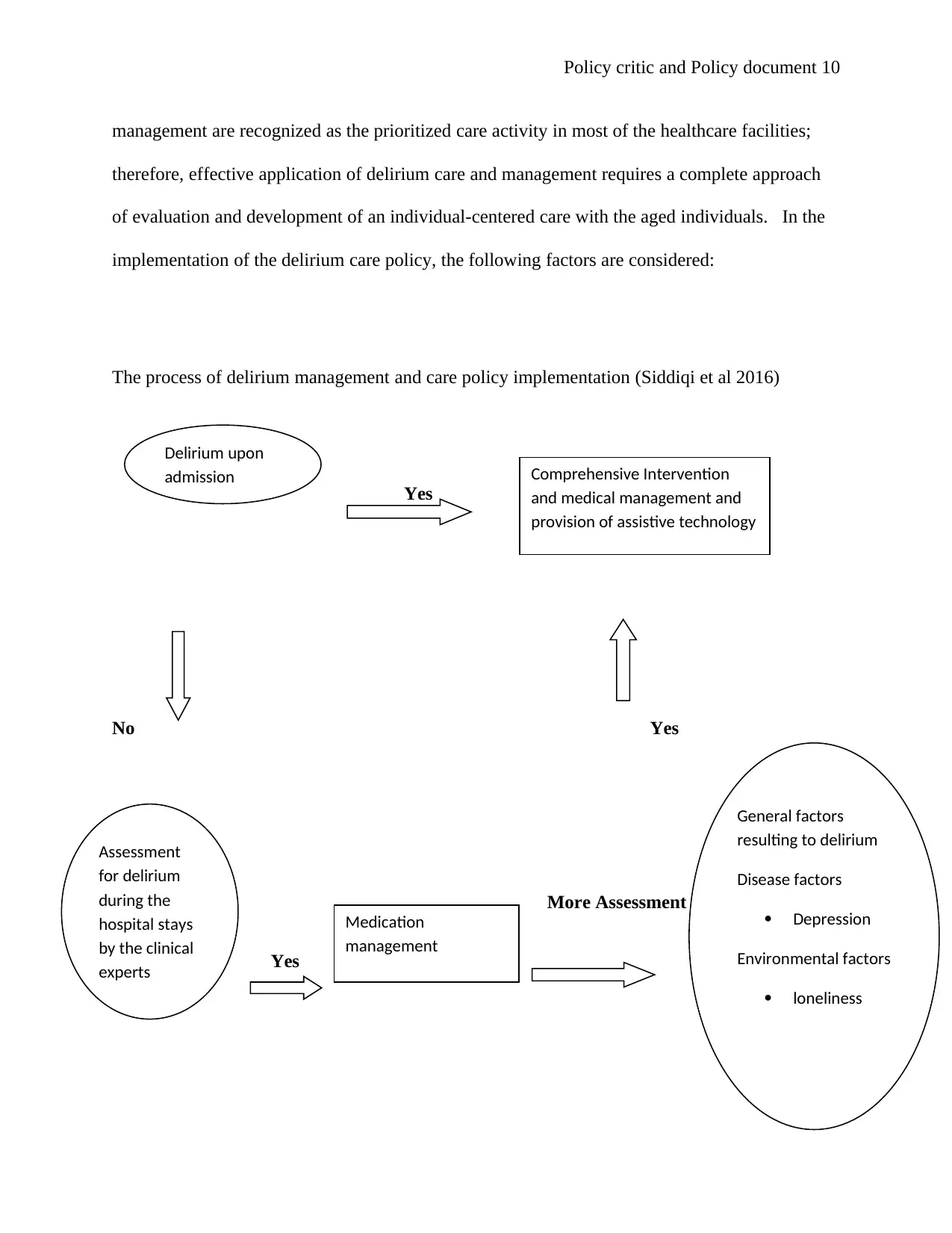
Policy critic and Policy document 10
management are recognized as the prioritized care activity in most of the healthcare facilities;
therefore, effective application of delirium care and management requires a complete approach
of evaluation and development of an individual-centered care with the aged individuals. In the
implementation of the delirium care policy, the following factors are considered:
The process of delirium management and care policy implementation (Siddiqi et al 2016)
Yes
No Yes
More Assessment
Yes Yes
Delirium upon
admission
Assessment
for delirium
during the
hospital stays
by the clinical
experts
General factors
resulting to delirium
Disease factors
Depression
Environmental factors
loneliness
Comprehensive Intervention
and medical management and
provision of assistive technology
Medication
management
exercise
management are recognized as the prioritized care activity in most of the healthcare facilities;
therefore, effective application of delirium care and management requires a complete approach
of evaluation and development of an individual-centered care with the aged individuals. In the
implementation of the delirium care policy, the following factors are considered:
The process of delirium management and care policy implementation (Siddiqi et al 2016)
Yes
No Yes
More Assessment
Yes Yes
Delirium upon
admission
Assessment
for delirium
during the
hospital stays
by the clinical
experts
General factors
resulting to delirium
Disease factors
Depression
Environmental factors
loneliness
Comprehensive Intervention
and medical management and
provision of assistive technology
Medication
management
exercise
Paraphrase This Document
Need a fresh take? Get an instant paraphrase of this document with our AI Paraphraser
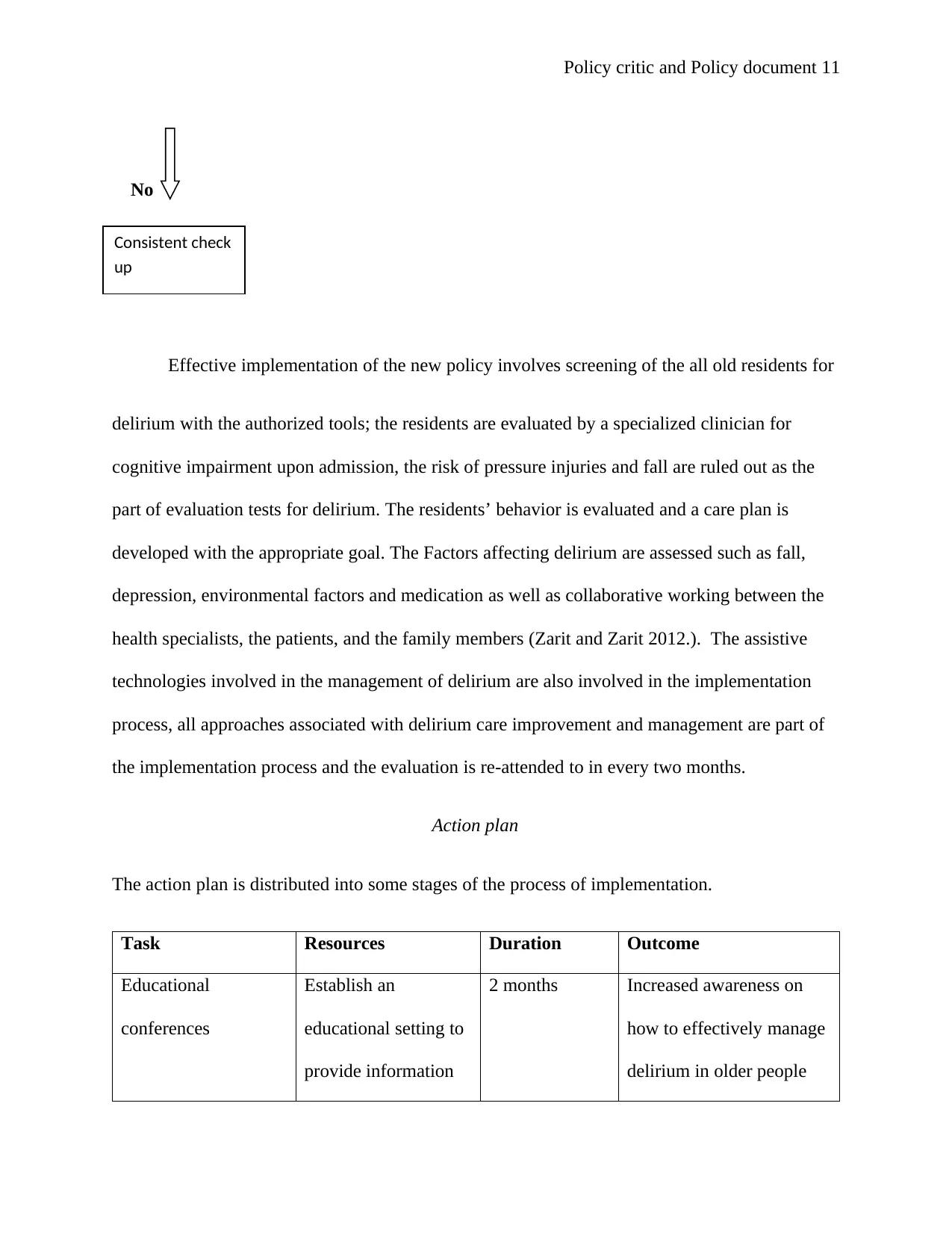
Policy critic and Policy document 11
No
Effective implementation of the new policy involves screening of the all old residents for
delirium with the authorized tools; the residents are evaluated by a specialized clinician for
cognitive impairment upon admission, the risk of pressure injuries and fall are ruled out as the
part of evaluation tests for delirium. The residents’ behavior is evaluated and a care plan is
developed with the appropriate goal. The Factors affecting delirium are assessed such as fall,
depression, environmental factors and medication as well as collaborative working between the
health specialists, the patients, and the family members (Zarit and Zarit 2012.). The assistive
technologies involved in the management of delirium are also involved in the implementation
process, all approaches associated with delirium care improvement and management are part of
the implementation process and the evaluation is re-attended to in every two months.
Action plan
The action plan is distributed into some stages of the process of implementation.
Task Resources Duration Outcome
Educational
conferences
Establish an
educational setting to
provide information
2 months Increased awareness on
how to effectively manage
delirium in older people
Consistent check
up
No
Effective implementation of the new policy involves screening of the all old residents for
delirium with the authorized tools; the residents are evaluated by a specialized clinician for
cognitive impairment upon admission, the risk of pressure injuries and fall are ruled out as the
part of evaluation tests for delirium. The residents’ behavior is evaluated and a care plan is
developed with the appropriate goal. The Factors affecting delirium are assessed such as fall,
depression, environmental factors and medication as well as collaborative working between the
health specialists, the patients, and the family members (Zarit and Zarit 2012.). The assistive
technologies involved in the management of delirium are also involved in the implementation
process, all approaches associated with delirium care improvement and management are part of
the implementation process and the evaluation is re-attended to in every two months.
Action plan
The action plan is distributed into some stages of the process of implementation.
Task Resources Duration Outcome
Educational
conferences
Establish an
educational setting to
provide information
2 months Increased awareness on
how to effectively manage
delirium in older people
Consistent check
up
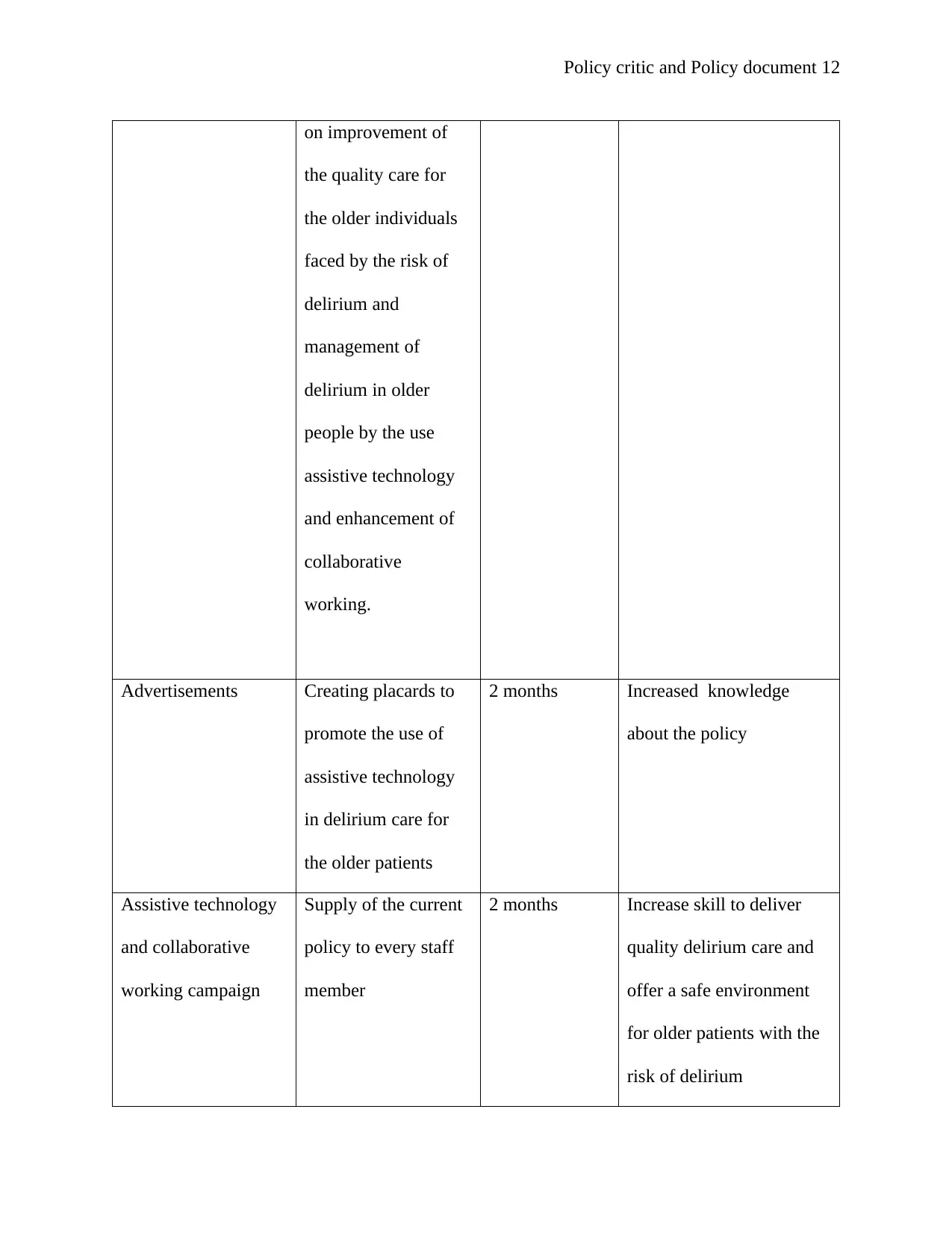
Policy critic and Policy document 12
on improvement of
the quality care for
the older individuals
faced by the risk of
delirium and
management of
delirium in older
people by the use
assistive technology
and enhancement of
collaborative
working.
Advertisements Creating placards to
promote the use of
assistive technology
in delirium care for
the older patients
2 months Increased knowledge
about the policy
Assistive technology
and collaborative
working campaign
Supply of the current
policy to every staff
member
2 months Increase skill to deliver
quality delirium care and
offer a safe environment
for older patients with the
risk of delirium
on improvement of
the quality care for
the older individuals
faced by the risk of
delirium and
management of
delirium in older
people by the use
assistive technology
and enhancement of
collaborative
working.
Advertisements Creating placards to
promote the use of
assistive technology
in delirium care for
the older patients
2 months Increased knowledge
about the policy
Assistive technology
and collaborative
working campaign
Supply of the current
policy to every staff
member
2 months Increase skill to deliver
quality delirium care and
offer a safe environment
for older patients with the
risk of delirium
⊘ This is a preview!⊘
Do you want full access?
Subscribe today to unlock all pages.

Trusted by 1+ million students worldwide
1 out of 24
Related Documents
Your All-in-One AI-Powered Toolkit for Academic Success.
+13062052269
info@desklib.com
Available 24*7 on WhatsApp / Email
![[object Object]](/_next/static/media/star-bottom.7253800d.svg)
Unlock your academic potential
Copyright © 2020–2025 A2Z Services. All Rights Reserved. Developed and managed by ZUCOL.





